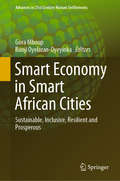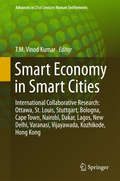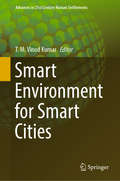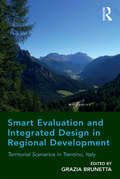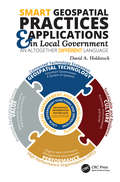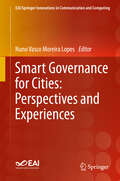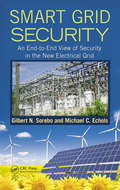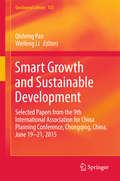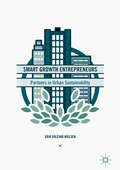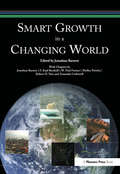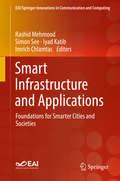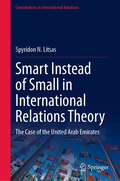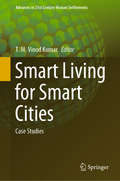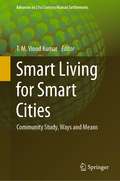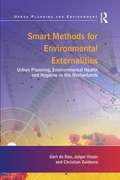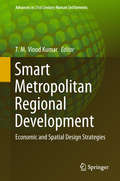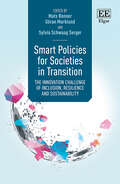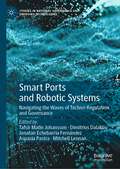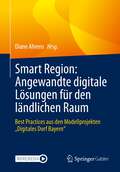- Table View
- List View
Smart Economy in Smart African Cities: Sustainable, Inclusive, Resilient and Prosperous (Advances in 21st Century Human Settlements)
by Gora Mboup Banji Oyelaran-OyeyinkaThis book highlights the use of information and communication technology (ICT) infrastructures in order to develop smart cities and produce smart economies in Africa. It discusses a robust set of concepts, including smart planning, smart infrastructure development, smart economic development, smart environmental sustainability, smart social development, resilience, and smart peace and security in several African cities. By drawing on the accumulated knowledge on various conditions that make cities smart, green, livable and healthy, it helps in the planning, design and management of African urbanization. In turn, it fosters the development of e-commerce, e-education, e-governance, etc. The rapid development of ICT infrastructures facilitates the creation of smart economies in digitally served cities and towns through smart urban planning, smart infrastructures, smart land tenure and smart urban policies. In the long term, this can reduce emissions of CO2, promote the creation of low carbon cities, reduce land degradation and promote biodiversity.
Smart Economy in Smart Cities: International Collaborative Research: Ottawa, St.Louis, Stuttgart, Bologna, Cape Town, Nairobi, Dakar, Lagos, New Delhi, Varanasi, Vijayawada, Kozhikode, Hong Kong (Advances in 21st Century Human Settlements)
by T. M. Vinod KumarThe present book highlights studies that show how smart cities promote urban economic development. The book surveys the state of the art of Smart City Economic Development through a literature survey. The book uses 13 in depth city research case studies in 10 countries such as the North America, Europe, Africa and Asia to explain how a smart economy changes the urban spatial system and vice versa. This book focuses on exploratory city studies in different countries, which investigate how urban spatial systems adapt to the specific needs of smart urban economy. The theory of smart city economic development is not yet entirely understood and applied in metropolitan regional plans. Smart urban economies are largely the result of the influence of ICT applications on all aspects of urban economy, which in turn changes the land-use system. It points out that the dynamics of smart city GDP creation takes ‘different paths,’ which need further empirical study, hypothesis testing and mathematical modelling. Although there are hypotheses on how smart cities generate wealth and social benefits for nations, there are no significant empirical studies available on how they generate urban economic development through urban spatial adaptation. This book with 13 cities research studies is one attempt to fill in the gap in knowledge base.
Smart Environment for Smart Cities (Advances in 21st Century Human Settlements)
by T.M. Vinod KumarThis book discusses the design and practice of environmental resources management for smart cities. Presenting numerous city case studies, it focuses on one specific environmental resource in each city. Environmental resources are commonly owned properties that require active inputs from the government and the people, and in any smart city their management calls for a synchronous combination of e-democracy, e-governance and IOT (Internet of Things) systems in a 24/7 framework. Smart environmental resources management uses information and communication technologies, the Internet of Things, internet of governance (e-governance) and internet of people (e-democracy) along with conventional resource management tools to achieve coordinated, effective and efficient management, development, and conservation that equitably improves ecological and economic welfare, without compromising the sustainability of development ecosystems and stakeholders.
Smart Evaluation and Integrated Design in Regional Development: Territorial Scenarios in Trentino, Italy
by Grazia BrunettaSmart Evaluation and Integrated Design in Regional Development puts forward an alternative approach to evaluation in spatial planning - one that focuses on ’territory’ and ’landscape’. The book introduces an innovative evaluation approach, namely Territorial Integrated Evaluation (TIE), a meta-evaluation methodology for designing regional development scenarios. A research team from the Politecnico di Torino applied this methodology experimentally to the practices of spatial planning in Trentino in order to aid the Province in a process of institutional innovation that is still going on today. TIE defines territorial scenarios serving the need for regional economic development as well as the conservation of nature and landscape. A cross-border region, Trentino has a special need to harmonize economic development with the exceptional and internationally renowned value of its landscape which includes the Dolomites, a UNESCO World Heritage Site. Therefore TIE set out to design regional development scenarios that integrated various topics - retail, tourism, infrastructures, nature and landscape. By testing out TIE in practice in this extraordinarily dynamic institutional context, the book makes a significant contribution to the discussion about newly emerging approaches to spatial planning that involve multidisciplinary vision, new paradigms in regional development, and institutional learning and capability in decision-making.
Smart Evaluation and Integrated Design in Regional Development: Territorial Scenarios in Trentino, Italy
by Grazia BrunettaSmart Evaluation and Integrated Design in Regional Development puts forward an alternative approach to evaluation in spatial planning - one that focuses on ’territory’ and ’landscape’. The book introduces an innovative evaluation approach, namely Territorial Integrated Evaluation (TIE), a meta-evaluation methodology for designing regional development scenarios. A research team from the Politecnico di Torino applied this methodology experimentally to the practices of spatial planning in Trentino in order to aid the Province in a process of institutional innovation that is still going on today. TIE defines territorial scenarios serving the need for regional economic development as well as the conservation of nature and landscape. A cross-border region, Trentino has a special need to harmonize economic development with the exceptional and internationally renowned value of its landscape which includes the Dolomites, a UNESCO World Heritage Site. Therefore TIE set out to design regional development scenarios that integrated various topics - retail, tourism, infrastructures, nature and landscape. By testing out TIE in practice in this extraordinarily dynamic institutional context, the book makes a significant contribution to the discussion about newly emerging approaches to spatial planning that involve multidisciplinary vision, new paradigms in regional development, and institutional learning and capability in decision-making.
Smart Geospatial Practices and Applications in Local Government: An Altogether Different Language
by David A. HoldstockThe demand on local government to do more with less by improving operations, increasing productivity, and making better and more informed decisions increases constantly. On a departmental level Geographic Information Systems are helping meet this demand but the majority of local government organizations do not take the time to understand the GIS needs and opportunities of each and every department. This book: Discusses how towns, cities and counties and their specific departments should actually use GIS Explains the best ways to use GIS tools through many specific case studies and step by step instructions Emphasises local government needs first before offering solutions Gives readers a practical and understandable way of thinking about managing and making GIS successful This book is the guide that details best GIS applications and practices for the 34 departments in local government that can, and should, use GIS technology. It explains in details how, why, and what each department should implement, a clear and understandable explanation of departmental GIS.
Smart Geospatial Practices and Applications in Local Government: An Altogether Different Language
by David A. HoldstockThe demand on local government to do more with less by improving operations, increasing productivity, and making better and more informed decisions increases constantly. On a departmental level Geographic Information Systems are helping meet this demand but the majority of local government organizations do not take the time to understand the GIS needs and opportunities of each and every department. This book: Discusses how towns, cities and counties and their specific departments should actually use GIS Explains the best ways to use GIS tools through many specific case studies and step by step instructions Emphasises local government needs first before offering solutions Gives readers a practical and understandable way of thinking about managing and making GIS successful This book is the guide that details best GIS applications and practices for the 34 departments in local government that can, and should, use GIS technology. It explains in details how, why, and what each department should implement, a clear and understandable explanation of departmental GIS.
Smart Governance for Cities: Perspectives and Experiences (EAI/Springer Innovations in Communication and Computing)
by Nuno Vasco Moreira LopesThis book provides theoretical perspectives and practical experiences on smart governance for smart cities. It presents a balanced linkage between research, policies and practices on this area. The authors discuss the sustainability challenges raised by rapid urbanization, challenges with smart governance models in various countries, and a new governance paradigm seen as a capable approach able to overcome social, economic and environmental sustainability problems. The authors include case studies on transformation, adaption and transfers; and country, regional, municipal contextualization. Also included are best practices on monitoring and evaluating smart governance and impact assessment. The book features contributions from researchers, academics, and practitioners in the field. Analyzes smart governance for cities from a variety of perspectives and a variety of sectors – both in theory and in practiceFeatures information on the linkage between United Nations Sustainable Development Goals and smart governanceCovers the connection between research, policies and practice in smart governance for smart cities
Smart Grid Security: An End-to-End View of Security in the New Electrical Grid
by Gilbert N. Sorebo Michael C. EcholsThe Smart Grid has the potential to revolutionize electricity delivery systems, and the security of its infrastructure is a vital concern not only for cyber-security practitioners, engineers, policy makers, and utility executives, but also for the media and consumers. Smart Grid Security: An End-to-End View of Security in the New Electrical Grid ex
Smart Growth and Sustainable Development: Selected Papers from the 9th International Association for China Planning Conference, Chongqing, China, June 19 - 21, 2015 (GeoJournal Library #122)
by Qisheng Pan Weifeng LiThis book explores how to tackle the challenges of urbanization through international lessons in sustainable development and smart growth strategies. As readers will discover, smart growth offers an approach to urbanization with the aim to: improve the efficiency of land use, protect the natural and cultural environment, promote economic prosperity and improve the quality of life. Authors address various challenges experienced in China, including deepening regional imbalances, an aging population, wholesale environmental degradation and traffic congestion. China’s official long-term urbanization plan sets many challenges for urban planners, these range from implementation of the plan and financing, to protection of vulnerable groups and social justice. This book brings readers up to date on the use of big data and modern technologies such as geographic information system technology (GIS). The work encompasses themes of environmental planning, community development, cultural heritage preservation, land use and transportation, urban studies, climate change, housing and community development, infrastructure planning, disaster planning and social equity. Authors present the very latest theories and practices of smart growth and offer many valuable insights to urban planners and scholars, as well as policy makers.
Smart Growth Entrepreneurs: Partners in Urban Sustainability
by Erik Solevad NielsenThis book examines smart growth entrepreneurs—innovators in government, development companies, architectural firms, and other organizations, who coalesce to shift policies and markets toward green planning and building practices. Cities across the world are trying to manage their population and economic growth by implementing the design principles of Smart Growth and New Urbanism, developing green buildings that are compact, mixed-use, and in close proximity to transit services. How do innovators, governments, and markets interact in this planning and development process? The book profiles smart growth entrepreneurs and their projects in both Southern California and the suburbs of Portland, Oregon. The author highlights the unique obstacles, political and economic, that these actors encounter and details the centrality of markets and regulations in sustainable urban development.
Smart Growth Entrepreneurs: Partners in Urban Sustainability
by Erik Solevad NielsenThis book examines smart growth entrepreneurs—innovators in government, development companies, architectural firms, and other organizations, who coalesce to shift policies and markets toward green planning and building practices. Cities across the world are trying to manage their population and economic growth by implementing the design principles of Smart Growth and New Urbanism, developing green buildings that are compact, mixed-use, and in close proximity to transit services. How do innovators, governments, and markets interact in this planning and development process? The book profiles smart growth entrepreneurs and their projects in both Southern California and the suburbs of Portland, Oregon. The author highlights the unique obstacles, political and economic, that these actors encounter and details the centrality of markets and regulations in sustainable urban development.
Smart Growth in a Changing World
by Jonathan BarnettThis book is the latest book from the author, documents the United States' hidden crisis and shows how balanced transportation and natural resources preservation can make new urban development sustainable, as well as more efficient and more equitable.
Smart Growth in a Changing World
by Jonathan BarnettThis book is the latest book from the author, documents the United States' hidden crisis and shows how balanced transportation and natural resources preservation can make new urban development sustainable, as well as more efficient and more equitable.
Smart Infrastructure and Applications: Foundations for Smarter Cities and Societies (EAI/Springer Innovations in Communication and Computing #224)
by Rashid Mehmood Simon See Iyad Katib Imrich ChlamtacThis book provides a multidisciplinary view of smart infrastructure through a range of diverse introductory and advanced topics. The book features an array of subjects that include: smart cities and infrastructure, e-healthcare, emergency and disaster management, Internet of Vehicles, supply chain management, eGovernance, and high performance computing. The book is divided into five parts: Smart Transportation, Smart Healthcare, Miscellaneous Applications, Big Data and High Performance Computing, and Internet of Things (IoT). Contributions are from academics, researchers, and industry professionals around the world. Features a broad mix of topics related to smart infrastructure and smart applications, particularly high performance computing, big data, and artificial intelligence; Includes a strong emphasis on methodological aspects of infrastructure, technology and application development; Presents a substantial overview of research and development on key economic sectors including healthcare and transportation.
Smart Instead of Small in International Relations Theory: The Case of the United Arab Emirates (Contributions to International Relations)
by Spyridon N. LitsasSmall States theory supports the argument that small international actors have a vital role in the international system. After 9/11, it emerged as a more focused attempt to show that 'small' can be 'attractive and functional' in an era of normative political and religious radicalism. This book argues that Small States Theory is not relevant to the perplexities of the post-multipolar international system and produces a new theory, the Smart States Theory. Based on structural and neoclassical realism, it attempts to identify the origins of 'state-smartness' in foreign policy, leadership, and domestic politics. The United Arab Emirates will be used as the case study of this novel theoretical approach. The impressive evolution of the Trucial States to a modern nation-state of high technology, dynamic foreign policy as the recent pandemic fully showed, unique leadership, and unparalleled tolerance towards other religions and cultures, make the UAE a brilliant example of a smart state of the 21st century. The reader of the book will be introduced to a new theory in International Relations as well as to the history, politics, society, and leadership of a state that plays a pivotal role not only in the Gulf region but in the broader framework of the Middle East too; the United Arab Emirates.
Smart Living for Smart Cities: Case Studies (Advances in 21st Century Human Settlements)
by T. M. Vinod KumarThis book, based on extensive international collaborative research, highlights the state-of-the-art design of “smart living” for metropolises, megacities, and metacities, as well as at the community and neighbourhood level. Smart living is one of six main components of smart cities, the others being smart people, smart economy, smart environment, smart mobility and smart governance. Smart living in any smart city can only be designed and implemented with active roles for smart people and smart city government, and as a joint effort combining e-Democracy, e-Governance and ICT-IoT systems. In addition to using information and communication technologies, the Internet of Things, Internet of Governance (e-Governance) and Internet of People (e-Democracy), the design of smart living utilizes various domain-specific tools to achieve coordinated, effective and efficient management, development, and conservation, and to improve ecological, social, biophysical, psychological and economic well-being in an equitable manner without compromising the sustainability of development ecosystems and stakeholders. This book presents case studies covering more than 10 cities and centred on domain-specific smart living components. The book is issued in two volumes. and this volume focus on city studies.
Smart Living for Smart Cities: Community Study, Ways and Means (Advances in 21st Century Human Settlements)
by T. M. Vinod KumarThis book, based on extensive international collaborative research, highlights the state-of-the-art design of smart living for metropolises, megacities, and metacities, as well as at the community and neighbourhood level. Smart living is one of six main components of smart cities, the others being smart people, smart economy, smart environment, smart mobility and smart governance. Smart living in any smart city can only be designed and implemented with active roles for smart people and smart city government, and as a joint effort combining e-Democracy, e-Governance and ICT-IoT systems. In addition to using information and communication technologies, the Internet of Things, Internet of Governance (e-Governance) and Internet of People (e-Democracy), the design of smart living utilizes various domain-specific tools to achieve coordinated, effective and efficient management, development, and conservation, and to improve ecological, social, biophysical, psychological and economic well-being in an equitable manner without compromising the sustainability of development ecosystems and stakeholders. This book presents case studies covering more than 10 cities and centred on domain-specific smart living components. The book is issued in two volumes and this volume focus on community studies and ways and means.
Smart Methods for Environmental Externalities: Urban Planning, Environmental Health and Hygiene in the Netherlands
by Gert de Roo Jelger VisserIn recent years, Dutch environmental policy has undergone some pivotal changes, the most significant of which have been decentralization and deregulation, encouraging local communities to develop and deliver policies which are tailor-made to their particular situation. These changes have led to the development of some innovative practical instruments for aiding sustainable environmental spatial policy. This book discusses these new 'methods for environmental externalities' and their significance in the development and delivery of Dutch environmental policies, particularly how they ensure that issues such as health and hygiene are introduced in the early stages of spatial planning processes. This book highlights the most prominent and relevant of these innovative 'methods for environmental externalities' as well as comparing them with some of the classic methods, and analysing strengths and weaknesses. It argues that having such a broad and varied choice of methods is the key to ensuring the impressive and groundbreaking Dutch creativity in environmental management. In conclusion, the book extrapolates current trends in environmental policy, expresses likely and possible developments in 'methods for environmental externalities' and shows how such methods can contribute in our ongoing attempts to develop and deliver liveable, pleasant and sustainable towns and cities.
Smart Methods for Environmental Externalities: Urban Planning, Environmental Health and Hygiene in the Netherlands
by Gert de Roo Jelger VisserIn recent years, Dutch environmental policy has undergone some pivotal changes, the most significant of which have been decentralization and deregulation, encouraging local communities to develop and deliver policies which are tailor-made to their particular situation. These changes have led to the development of some innovative practical instruments for aiding sustainable environmental spatial policy. This book discusses these new 'methods for environmental externalities' and their significance in the development and delivery of Dutch environmental policies, particularly how they ensure that issues such as health and hygiene are introduced in the early stages of spatial planning processes. This book highlights the most prominent and relevant of these innovative 'methods for environmental externalities' as well as comparing them with some of the classic methods, and analysing strengths and weaknesses. It argues that having such a broad and varied choice of methods is the key to ensuring the impressive and groundbreaking Dutch creativity in environmental management. In conclusion, the book extrapolates current trends in environmental policy, expresses likely and possible developments in 'methods for environmental externalities' and shows how such methods can contribute in our ongoing attempts to develop and deliver liveable, pleasant and sustainable towns and cities.
Smart Metropolitan Regional Development: Economic and Spatial Design Strategies (Advances in 21st Century Human Settlements)
by T.M. Vinod KumarThis book discusses the concept and practice of a smart metropolitan region, and how smart cities promote healthy economic and spatial development. It highlights how smart metropolitan regional development can energize, reorganize and transform the legacy economy into a smart economy; how it can help embrace Information and Communications Technology (ICT); and how it can foster a shared economy. In addition, it outlines how the five pillars of the third industrial revolution can be achieved by smart communities. In addition, the book draws on 16 in-depth city case studies from ten countries to explore the state of the art regarding the smart economy in smart cities – and to apply the lessons learned to shape smart metropolitan economic and spatial development.
Smart on Crime: The Struggle to Build a Better American Penal System
by Garrick L. PercivalThe most punitive era in American history reached its apex in the 1990s, but the trend has reversed in recent years. Smart on Crime: The Struggle to Build a Better American Penal System examines the factors causing this dramatic turnaround. It relates and echoes the increasing need and desire on the part of actors in the American government system
Smart Policies for Societies in Transition: The Innovation Challenge of Inclusion, Resilience and Sustainability
This is an open access title available under the terms of a CC BY-NC-ND 4.0 License. It is free to read, download and share on Elgaronline thanks to generous funding support from The Swedish Governmental Agency For Innovation Systems, Vinnova.This timely book expertly examines ongoing pressing issues in the modern world namely, an unstable economic climate, political turmoil and the environmental crisis. It takes a unique look at how science, technology and innovation could contribute towards the creation of a smarter and more resilient society by allowing more inclusive approaches into how science is integrated.With an insightful global interdisciplinary approach, Smart Policies for Societies in Transition combines in-depth theoretical analysis whilst also providing a reflective look at broadening the scope of science and innovation policy in order to understand the critical issues and challenges. Chapters illustrate historical practices and events, and discuss how the move to smart politics and the linking of boundaries from a social, ecological and global viewpoint leads to fewer but more creative policies.With its retrospective and forward-thinking perspectives, this book will be an excellent resource for academics wanting to rethink their approach to science and innovation governance, whilst scholars will find the collaborative method for combining policy analysis with theory of policymaking and governance informative and illuminating.
Smart Ports and Robotic Systems: Navigating the Waves of Techno-Regulation and Governance (Studies in National Governance and Emerging Technologies)
by Tafsir Matin Johansson Dimitrios Dalaklis Jonatan Echebarria Fernández Aspasia Pastra Mitchell LennanThis book provides a comprehensive overview of smart ports and remote technologies in the maritime industry. It demonstrates how modern advances in artificial intelligence and robotics have transformed the shipping industry, and assesses the impact of this technology from a law and governance standpoint. The book covers a range of topics including port autonomous operations systems, cybersecurity, big data analytics, digitalization and blockchain to throw light on the opportunities and benefits of these new technologies in improving security and safety. It also considers the challenges and threats of their application. It concludes by examining the trajectory of national and international regulatory developments. The book will appeal to scholars and students of maritime technology, law and governance, as well as practitioners and policymakers.Chapters 8, 19 and 20 are available open access under a Creative Commons Attribution 4.0 International License via link.springer.com.
Smart Region: Best Practices aus den Modellprojekten „Digitales Dorf Bayern“
by Diane AhrensKann digitale Transformation im ländlichen Raum als Chance zur Verbesserung gleichwertiger Lebensverhältnisse genutzt werden? Anhand von drei bayerischen Modellregionen wurden in zahlreichen Handlungsfeldern – z.B. Gesundheit und Pflege, Mobilität, Kirche, Arbeiten, Schule und Bildung - digitale Lösungen gemeinsam mit Betroffenen entwickelt, eingeführt und getestet. Aufgrund des ganzheitlichen Projektfokus sind „Living Labs“ entstanden, die Synergien, Potentiale, aber auch Herausforderungen deutlich machen und zeigen, dass ländliche Räume eigene Anforderungen haben, die sich maßgeblich von „Smart Cities“ unterscheiden.
